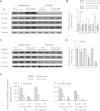Dietary regulation of mouse intestinal P450 expression and drug metabolism
- PMID: 23160819
- PMCID: PMC3558856
- DOI: 10.1124/dmd.112.049403
Dietary regulation of mouse intestinal P450 expression and drug metabolism
Abstract
The study was originally designed to test the hypothesis that the compensatory increase in intestinal P450 (cytochrome P450) expression in the intestinal epithelium-specific P450 reductase (CPR) knockout (IE-Cpr-null) mice was attributable to decreased metabolism of putative P450 inducers present in the diet. Thus, we determined the impact of a dietary change from regular rodent chow to a synthetic diet devoid of phytochemicals on the expression of P450 enzymes in the small intestine (SI) and liver of wild-type (WT) and IE-Cpr-null mice. The dietary change diminished expression of CYP1A, 2B, 2C, and 3A in SI and CYP2B, 2C, and 3A in liver of both WT and IE-Cpr-null mice. However, the compensatory increase in SI P450 expression still occurred in IE-Cpr-null, compared with WT, mice, on the synthetic diet. The diet change-induced decrease in P450 expression was accompanied by decreases in microsomal midazolam-hydroxylase activity in vitro and first-pass clearance of midazolam in vivo in WT mice. Further studies showed that the dietary change, but not Cpr deletion, caused large decreases in bile acid (BA) levels in plasma, liver, SI, and intestinal content and that treatment of WT mice on the synthetic diet with GW4064, a farnesoid-X-receptor agonist, restored the levels of CYP3A expression in both liver and SI to those seen in mice fed with regular chow. Taken together, these results highlight the vital role of diet in maintaining adequate expression of major drug-metabolizing P450s and their associated drug-metabolizing activities in the digestive tract and suggest potential involvement of BA signaling in the regulatory mechanisms.
Figures



Similar articles
-
Regulation of intestinal cytochrome P450 expression by hepatic cytochrome P450: possible involvement of fibroblast growth factor 15 and impact on systemic drug exposure.Mol Pharmacol. 2014 Jan;85(1):139-47. doi: 10.1124/mol.113.088914. Epub 2013 Nov 1. Mol Pharmacol. 2014. PMID: 24184963 Free PMC article.
-
An intestinal epithelium-specific cytochrome P450 (P450) reductase-knockout mouse model: direct evidence for a role of intestinal p450s in first-pass clearance of oral nifedipine.Drug Metab Dispos. 2009 Mar;37(3):651-7. doi: 10.1124/dmd.108.025429. Epub 2008 Dec 4. Drug Metab Dispos. 2009. PMID: 19056912 Free PMC article.
-
Decreased bile-acid synthesis in livers of hepatocyte-conditional NADPH-cytochrome P450 reductase-null mice results in increased bile acids in serum.J Pharmacol Exp Ther. 2014 Oct;351(1):105-13. doi: 10.1124/jpet.114.216796. Epub 2014 Jul 17. J Pharmacol Exp Ther. 2014. PMID: 25034404 Free PMC article.
-
The role of small-intestinal P450 enzymes in protection against systemic exposure of orally administered benzo[a]pyrene.J Pharmacol Exp Ther. 2010 Jul;334(1):156-63. doi: 10.1124/jpet.110.167742. Epub 2010 Apr 16. J Pharmacol Exp Ther. 2010. PMID: 20400470 Free PMC article.
-
Adaptive hepatic and intestinal alterations in mice after deletion of NADPH-cytochrome P450 Oxidoreductase (Cpr) in hepatocytes.Drug Metab Dispos. 2014 Nov;42(11):1826-33. doi: 10.1124/dmd.114.060053. Epub 2014 Aug 21. Drug Metab Dispos. 2014. PMID: 25147274 Free PMC article.
Cited by
-
Advancements in Plant-Derived sRNAs Therapeutics: Classification, Delivery Strategies, and Therapeutic Applications.Int J Mol Sci. 2025 Apr 30;26(9):4277. doi: 10.3390/ijms26094277. Int J Mol Sci. 2025. PMID: 40362513 Free PMC article. Review.
-
Regulation of intestinal cytochrome P450 expression by hepatic cytochrome P450: possible involvement of fibroblast growth factor 15 and impact on systemic drug exposure.Mol Pharmacol. 2014 Jan;85(1):139-47. doi: 10.1124/mol.113.088914. Epub 2013 Nov 1. Mol Pharmacol. 2014. PMID: 24184963 Free PMC article.
-
An update on the role of intestinal cytochrome P450 enzymes in drug disposition.Acta Pharm Sin B. 2016 Sep;6(5):374-383. doi: 10.1016/j.apsb.2016.07.012. Epub 2016 Aug 4. Acta Pharm Sin B. 2016. PMID: 27709006 Free PMC article. Review.
References
-
- Chiang JY. (1998) Regulation of bile acid synthesis. Front Biosci 3:d176–d193 - PubMed
-
- Doherty MM, Charman WN. (2002) The mucosa of the small intestine: how clinically relevant as an organ of drug metabolism? Clin Pharmacokinet 41:235–253 - PubMed
-
- Eeckhoudt SL, Desager JP, Horsmans Y, De Winne AJ, Verbeeck RK. (1998) Sensitive assay for midazolam and its metabolite 1′-hydroxymidazolam in human plasma by capillary high-performance liquid chromatography. J Chromatogr B Biomed Sci Appl 710:165–171 - PubMed
Publication types
MeSH terms
Substances
Grants and funding
LinkOut - more resources
Full Text Sources

